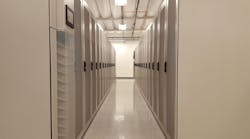In the data center industry, design is closely tied to business opportunities. This is increasingly true in 2015, as service providers use design refinements to target specific market opportunities.
Compass Datacenters recently unveiled a new design, providing more flexibility for customers to build larger and denser data centers. The company believes the new design, which features a heat wheel (Kyoto Cooling) technology, will open up new opportunities to win cloud computing business, offering cloud builders an alternative path to creating hyperscale cloud campuses.
The Compass update is the latest example of design refinements reflecting strategic initiatives in the data center industry, along with a focus on higher density at Colovore, a shift to variable resiliency plans at DuPont Fabros, and the “pay as you grow” approach at Aligned Data Centers. All are reflections of a larger reality: for most providers, the data center is no longer a “one size fits all” solution.
Efficiency Meets “Backwards-Compatible” Design
When Compass launched in 2012, its design was optimized to fit the demand profile of smaller markets, consistent with the company’s goal of extending the wholesale data center product beyond major tech hubs like Silicon Valley and northern Virginia. The original design featured pre-fabricated power rooms and concrete walls that could be assembled on-site to create a 1.2 megawatt stand-alone data center building, which met LEED Gold and Uptime Tier III certification standards. Early customers included Windstream, Iron Mountain, CenturyLink and American Electric power.
Compass CEO Chris Crosby said the new design, which offers up to 3.6 megawatts of capacity in a slightly larger building shell, represents an expansion beyond the company’s core strategy in second-tier markets. Compass has recently acquired land in Dallas and Atlanta, two markets that are of interest to wholesale data center customers.
“This is really our first significant design change,” said Crosby. “The customer can mix or match their sizes and density. We feel highly confident we can offer the lowest TCO of anyone for larger users like the cloud players. We can also continue to serve the tier two market. It’s a backwards-compatible way to expand the business. We still feel our single density product serves a large part of the market.”[clickToTweet tweet=”Chris Crosby: We feel highly confident we can offer the lowest TCO for larger cloud players. ” quote=”Chris Crosby: We feel highly confident we can offer the lowest TCO for larger cloud players. “]
In entering the major market arena, Compass will face stiff competition from established wholesale players with larger footprints, including some who will compete hard to win “super wholesale” deals that sometimes involve capacity in more than one market. It seems like a big challenge, but one leading player in data center site selection believes Compass will be competitive with its new approach.
“Compass has always offered a strong solution for Tier 2 and 3 markets, but the addition of these new capabilities and pricing structure make them a formidable competitor to even the largest MTDC (multi-tenant data center)providers in major markets like Dallas and Atlanta as well,” said Bo Bond, Managing Director at Jones Lang LaSalle. “Enabling customers to select their facility size and power density, personalize it to meet their requirements and have it delivered in six months, are capabilities that make Compass an attractive alternative to MTDC’s for any company seeking a new data center.”
Kyoto Heat Wheel Brings Cooling Savings
One of the most significant elements of the new design involves the cooling infrastructure, which has been shifted from the roof to the rear of the building. By adopting the Kyoto Cooling heat wheel (also known as a rotary heat exchanger), Compass has been able to gain the flexibility to expand power and cooling capacity, which was previously limited by roof space. It also improves the energy efficiency of the building, a key consideration for cloud-scale players.
The heat wheel uses indirect evaporative cooling, which eliminates the need for chillers in most operating conditions, but offers advantages over direct fresh air cooling, eliminating risk from contamination and humidity. Crosby expects the use of heat wheels will reduce the Power Usage Effectiveness (PUE) of Compass facilities from 1.25 to 1.1
“It’s significant to drop nearly 0.2 on a PUE,” said Crosby. “That goes through to the bottom line. It’s not reliant on a perfect outside air environment, or impacted by humidity. Most of the solutions out there are very dependent on geography.”
A data hall inside a Compass Datacenters facility. (Photo: Compass)
Crosby says the new design, combined with existing efficiencies in the company’s lean construction process, will allow Compass to offer a product that can compete with existing wholesale data center providers.
“This new suite of capabilities and pricing is a game changer for data center customers,” he said. “In the past, wholesale space was cheaper, but it came with a lot of tradeoffs. Unlike the big mega-facilities, these guys will be getting everything fully dedicated. You can mix and match 1.2 megawatt load groups with how much cooling you want, and every load group can be 2N if needed.”
The sizing options range from the initial 1.2 megawatts in a 10,000 square foot data hall up to 3.6 megawatts in a slightly larger 16,000 square foot data hall. Each facility includes a data hall, a support area including a secure lobby and access control, and an equipment yard featuring a pre-fab power room and cooling units. Each data center will be built on its own parcel of land, offering customers the ability to either lease or purchase the facility. In addition, every data center can be branded with the tenant’s logo and color scheme.
New Market Entry for Cloud Players?
What about scale? This is an important consideration, as hyperscale customers can do deals in 6 to 10 megawatt “super wholesale” chunks with providers like DuPont Fabros and Digital Realty. Crosby says a data center campus using the new Compass design can allow a phased expansion that accommodates up to 12 megawatts in five buildings on a 12-acre campus. Each building would have its own dedicated infrastructure (allowing them to operate each building as a failure domain).
“They could use Compass as a quick way to enter a market,” said Crosby. “If they like, we can build it and they can run the facility themselves.”
“Compass continues to alter the traditional economics for data centers by making dedicated facilities cost-competitive with wholesale solutions in multi-tenant facilities,” said Crosby. “Now you don’t need to settle for the disadvantages of wholesale space just to save on data center costs in even the largest markets. You can get an all-included, high-end, dedicated facility that is certified and highly-personalizable for the same price.”
Compass says it offers more than 75 ways to personalize a customer’s security systems, rack layouts, power distribution and branding. “That level of customization is something we really pride ourselves on,” said Crosby.






